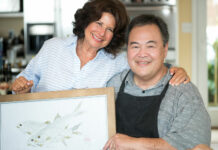Letter from Diane Haynes Woodburn
 “You made a challah!” My friend Leona Wilson smiles, happily accepting the rich, sweet egg bread.
“You made a challah!” My friend Leona Wilson smiles, happily accepting the rich, sweet egg bread.
Once a month, Leona gathers family and friends for kau kau (a pidgin word for “food”), and everyone brings something to share. “Would you explain the significance of the challah?” she asks.
And I do. It’s a Jewish bread, usually braided. The decorative poppy seeds on top represent manna from heaven. One of my fondest childhood memories was hearing the blessing over the bread as it was broken and shared with each person at the table.
Food plays an important role at Leona’s table, too, in no small part because it’s seasoned with lively conversation and laughter, and for our hostess, recalls days of growing up in a plantation camp.
Before lunch, Leona treats us to a tour of her palatial home, high up a slope of the West Maui Mountains. Much has changed in the decades since this island girl left for a career in New York. But the fields of sugarcane that brought her family here generations ago still green the mountain. Leona shows me a treasure from that earlier time: the lunchbox her grandfather used to carry when he worked in the cane fields at Hamakuapoko. The small double-decker container, with its well-worn wooden handle, is called a kau kau tin.
Every day, Leona’s grandmother would pack the tin with her grandfather’s midday meal. The bottom container held rice, and also held the heat that kept a meat dish in the top compartment warm. At lunchtime, Leona’s grandfather would join his coworkers — Japanese, Chinese, Portuguese, Filipino, Puerto Rican, Korean, and Spanish — and everyone would open their kau kau tins. Each man kept his portion of rice, but placed the aromatic meat dish in the middle for all to enjoy.
Sharing food helped cultures once foreign to each other cross barriers and become community. “One time,” Leona adds, “the workers noticed that a certain Japanese man hadn’t been bringing meat to share, only vegetables from his garden. He explained that he and his wife were saving every penny to send their children to college.”
I look at the kau kau tin with new appreciation. Leona’s words have transformed it into a symbol of the aspirations and sacrifices each generation made for the next. The tins held food and revealed their owners’ character — which also helped create the true flavor of Hawai‘i.
In this, our Best of Maui Dining issue, we celebrate our island’s culture through the prism of its multiethnic cuisine. And we do it with your help, as we share our twelfth annual ‘Aipono Awards, recognizing the best Maui restaurants and chefs as voted by you, our readers. Among them, Tylun Pang, executive chef at the Fairmont Kea Lani, winner of this year’s Lifetime Achievement Award. Chef Pang reimagined the Fairmont’s Ko restaurant, creating a setting and a menu inspired by Maui’s Plantation Era past. His contributions to Maui Culinary Academy, both financial and educational, are helping to train tomorrow’s great chefs.
In these pages, you will also meet the people behind Na Hoaloha ‘Ekolu — the restaurant group responsible for Old Lahaina Lu‘au, Aloha Mixed Plate, Star Noodle and Leoda’s Kitchen and Pie Shop — and learn how their desire to create dining experiences that honor Hawai‘i’s authentic foods and culture became a business model worthy of emulation, one that makes community service an integral part of its mission.
They’re not alone. Consider, for example, the younger generation of Maui chefs who created Grow Some Good, which teaches children how to grow, prepare and enjoy nutritious food. We’ll also introduce you to James Sagawinit, whose passion is to keep alive the craft of weaving fishnets and gathering the abundance of the sea, as Hawaiians have done for centuries.
As we gather at Leona’s table to begin our feast, someone asks, “Why is the challah braided?” Ah, this answer is easy. “The intertwined arms represent love,” I smile. “Very much like a kau kau tin.”
We invite you to share the heritage of our islands. Turn the pages; enjoy a taste.




